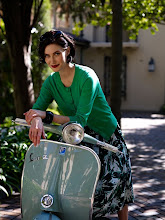a blog for all seasons
For those of you who haven't noticed the common thread of recent posts, a short synopsis is probably overdue. In The Fields was born out of an elective at Art School called Technologies in Painting: Vermeer to Richter which addresses a new concept within the history of painting each week. Our first class, along with colour mixing, looked at the use of text in painting.
Within the elective, Justin Balmain, our lecturer has highlighted the use of online mediums as an area of development for us, as future fine artists, to be conscious of and active in. In conjunction with our weekly classes he has encouraged us to publish our work online and build an online community where open discussion and exchange of ideas can take place. Essentially the format is open, but with a view to a future as a working artist it does force us to encounter it from that perspective. For me this may mean using the medium as a means of building a private support network, within which I can share and discuss my work. It may equally mean creating an open public forum for discussion of art related topics, that may reference my work, or purely as a voice into the outside world to affect my internal drive on a personal level. Like learning a new word, when learning a new skill-set the variety and extent of the applications for that skill are only fully realised after actually acquiring it. Initially disgruntled at the idea of running a blog, I have been blown away by the outcomes of the exercise.
The very nature of a blog is a fascinating one, it does seem to possess an energy of it's own and a momentum that, once begun and established, may well be a forceful one. I have included two links below of artists who I think are running blogs to great effect, for different reasons. Viewing different artist blogs inspires me to make further use of this medium. . .
Mia Oatley is a Sydney-based painter who studied at the National Art School and is now quite successfully represented by Richard Martin here in Paddington. Her blog, although completely different to anything I could see myself doing, is engaging, up to date and quite probably an aid to her success as an artist. Mia's blog is a good reference for the format of a fine artist blog.
www.miaoatley.com.au/
www.miaoatley-mia.blogspot.com/
Tommy Kane is an ex-advertising exec in New York who has decided he would like to turn his hand to art. I tripped over his illustration website online at some point and although I don't like his paintings, much of his work, nor his angle on art, I do like his coloured pencil illustrations, the manner of his dialogue adjoining them and throughout his blog site. He is comic, self-effacing and openly candid - it draws you into his world; his morning or his travels, his fascination with the Korean aesthetic of his wife or.. whatever he chooses to sketch that day, in NYC or abroad. Tommy's blog is a good reference for the format of an informal internal network blog.
www.tommykaneillustration.com
www.tommykane.blogspot.com/
Within the elective, Justin Balmain, our lecturer has highlighted the use of online mediums as an area of development for us, as future fine artists, to be conscious of and active in. In conjunction with our weekly classes he has encouraged us to publish our work online and build an online community where open discussion and exchange of ideas can take place. Essentially the format is open, but with a view to a future as a working artist it does force us to encounter it from that perspective. For me this may mean using the medium as a means of building a private support network, within which I can share and discuss my work. It may equally mean creating an open public forum for discussion of art related topics, that may reference my work, or purely as a voice into the outside world to affect my internal drive on a personal level. Like learning a new word, when learning a new skill-set the variety and extent of the applications for that skill are only fully realised after actually acquiring it. Initially disgruntled at the idea of running a blog, I have been blown away by the outcomes of the exercise.
The very nature of a blog is a fascinating one, it does seem to possess an energy of it's own and a momentum that, once begun and established, may well be a forceful one. I have included two links below of artists who I think are running blogs to great effect, for different reasons. Viewing different artist blogs inspires me to make further use of this medium. . .
Mia Oatley is a Sydney-based painter who studied at the National Art School and is now quite successfully represented by Richard Martin here in Paddington. Her blog, although completely different to anything I could see myself doing, is engaging, up to date and quite probably an aid to her success as an artist. Mia's blog is a good reference for the format of a fine artist blog.
www.miaoatley.com.au/
www.miaoatley-mia.blogspot.com/
Tommy Kane is an ex-advertising exec in New York who has decided he would like to turn his hand to art. I tripped over his illustration website online at some point and although I don't like his paintings, much of his work, nor his angle on art, I do like his coloured pencil illustrations, the manner of his dialogue adjoining them and throughout his blog site. He is comic, self-effacing and openly candid - it draws you into his world; his morning or his travels, his fascination with the Korean aesthetic of his wife or.. whatever he chooses to sketch that day, in NYC or abroad. Tommy's blog is a good reference for the format of an informal internal network blog.
www.tommykaneillustration.com
www.tommykane.blogspot.com/


